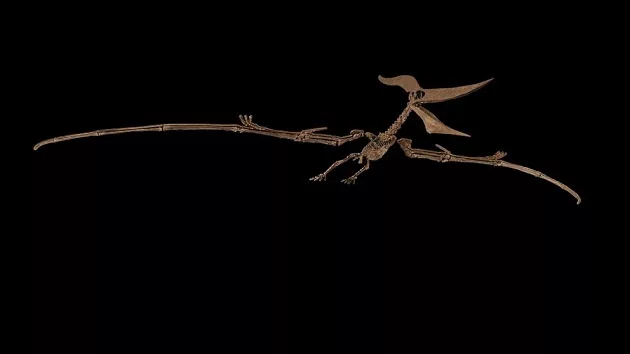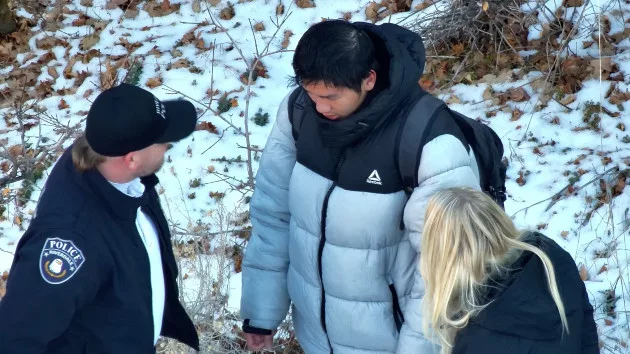
(NEW YORK) — A pair of dinosaur fossils of species that roamed the Earth millions of years ago are expected to garner millions in an upcoming auction.
The pterandon, described as one of the “largest” and “most fearsome species ever to roam Earth,” is predicted to fetch between $4 million and $6 million at auction, while the the fossils of the plesiosaur, the “best-preserved” of the species ever offered on the market, is expected to sell between $600,000 and $800,000, according to Sotheby’s.
The dinosaurs, “Horus” the pteranodon, nicknamed after the falcon-headed Egyptian god of kingship, protection and sky, and “Nessie” the plesiosaur, which shares the same nickname of the Loch Ness monster, are among the most feared predators to have ever lived on this planet, according to Sotheby’s.
The pteranodon, one of the largest known flying reptiles, lived in the late Cretaceous Period, around 100.5 million years ago to 66 million years ago, in North America in present-day Kansas, Nebraska, Wyoming, South Dakota and Alabama. The dinosaur would typically feed far from shore, sometimes hundreds of miles from the coastline, and would hunt aquatic prey by dipping or plunge diving.
In the air, pteranodons were superior over the feathered dinosaurs and birds during the Mesozoic Era, before going extinct at the end of the Cretaceous Period. The pteranodon is currently displayed in Sotheby’s galleries with wings outstretched in a soaring position and is mounted on a custom armature rigged for ceiling suspension.
The specimen for sale has a displayed wingspan of approximately 20 feet and is believed to be a fully mature adult. It was discovered in 2002 in what was once the Western Interior Seaway, an inland sea that divided the continent of North America into two landmasses, known as Laramidia and Appalachia, according to Sotheby’s.
Almost all of the original fossil bones remain on the pteranodon’s remains and are essentially unrestored, meaning that artificial filler was not used to replace missing bone sections. This makes the fossil “ideal” for scientific study and transparency of authenticity, according to Sotheby’s.
The exception is the pteranodon’s skull, which utilized 3D restoration for accurate and aesthetic display of skull sections that were not found at the dig site. Those fragments were replaced with high-resolution 3D printed elements, primarily mirrored from the specimen itself, according to Sotheby’s.
The plesiosaur, a long-extinct marine reptile, lived in the lower Jurassic Period, about 200 million years ago, and is thought to have inspired the legend of the Loch Ness Monster, a mythical creature in Scottish folklore that was believed to live in a lake in the Scottish Highlands.
They evolved a unique body design not seen in other marine creatures, with a relatively small head and jaws packed with numerous long pointed teeth on a snake-like neck. While the body of the plesiosaur was rigid, it could swim rapidly using its big, powerful flippers.
Plesiosaurs were extremely fast predatory reptiles, and may have hunted fish, squid and other small prey.
The specimen for sale was discovered in the 1990s in Gloucestershire, England, and measures nearly 11 feet in length. It is the most valuable of its kind to ever be offered at auction and the best preserved to ever come to market, according to Sotheby’s.
“Both of these species have long played an important role in our collective imaginations, from inspiring ancient folklore and myths to appearing in Hollywood blockbusters and television shows,” Cassandra Hatton, Sotheby’s global head of science and popular culture, said in a statement. “They are each instantly recognizable and are remarkable witnesses to the incredible evolutionary power that has shaped life on Earth for eons.”
A public exhibition for the fossils will open on July 20, while the live auction will take place on July 26.
Last year, Sotheby’s auctioned the first-ever Gorgosaurus skeleton in July 2022 for $6.1 million, and the first sale of a standalone Tyrannosaurus rex skull for $6.1 million the following December.
“These specimens mark the next significant new additions to Sotheby’s history of groundbreaking Natural History sales,” the auction house said of the dinosaur fossils up for auction.
The auction is part of Sotheby’s “Geek Week,” which features sales that celebrate the history of science & technology, space exploration and the natural world from July 18 to July 27.
Copyright © 2023, ABC Audio. All rights reserved.





